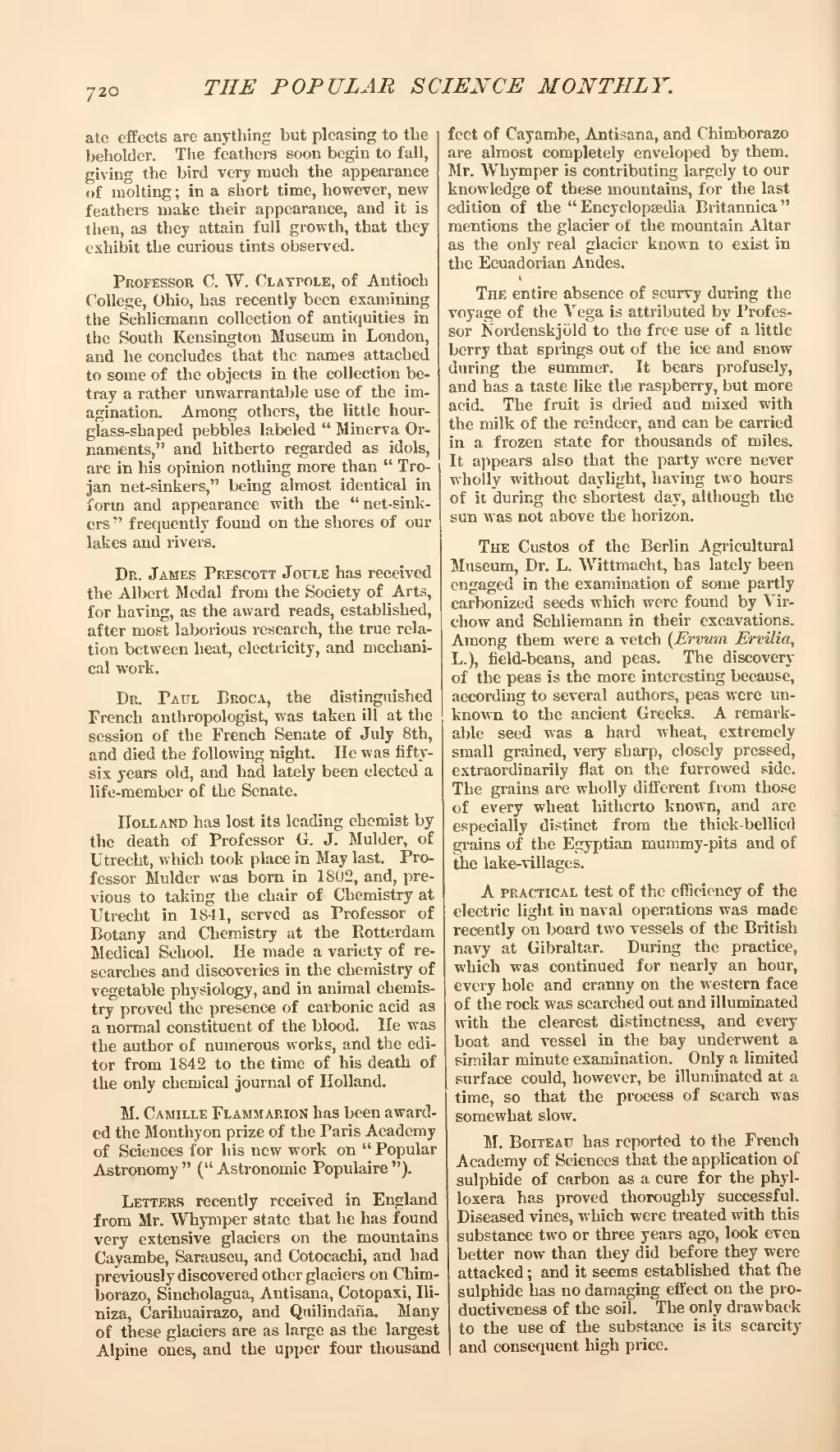ate effects are anything but pleasing to the beholder. The feathers soon begin to fall, giving the bird very much the appearance of molting; in a short time, however, new feathers make their appearance, and it is then, as they attain full growth, that they exhibit the curious tints observed.
Professor C. W. Claypole, of Antioch College, Ohio, has recently been examining the Schliemann collection of antiquities in the South Kensington Museum in London, and he concludes that the names attached to some of the objects in the collection betray a rather unwarrantable use of the imagination. Among others, the little hourglass-shaped pebbles labeled "Minerva Ornaments," and hitherto regarded as idols, are in his opinion nothing more than "Trojan net-sinkers," being almost identical in form and appearance with the "net-sinkers" frequently found on the shores of our lakes and rivers.
Dr. James Prescott Joule has received the Albert Medal from the Society of Arts, for having, as the award reads, established, after most laborious research, the true relation between heat, electricity, and mechanical work.
Dr. Paul Broca, the distinguished French anthropologist, was taken ill at the session of the French Senate of July 8th, and died the following night. He was fifty-six years old, and had lately been elected a life-member of the Senate.
Holland has lost its leading chemist by the death of Professor G. J. Mulder, of Utrecht, which took place in May last. Professor Mulder was born in 1802, and, previous to taking the chair of Chemistry at Utrecht in 1841, served as Professor of Botany and Chemistry at the Rotterdam Medical School. He made a variety of researches and discoveries in the chemistry of vegetable physiology, and in animal chemistry proved the presence of carbonic acid as a normal constituent of the blood. He was the author of numerous works, and the editor from 1842 to the time of his death of the only chemical journal of Holland.
M. Camille Flammarion has been awarded the Monthyon prize of the Paris Academy of Sciences for his new work on "Popular Astronomy" ("Astronomic Populaire").
Letters recently received in England from Mr. Whymper state that he has found very extensive glaciers on the mountains Cayambe, Sarauscu, and Cotocachi, and had previously discovered other glaciers on Chimborazo, Sincholagua, Antisana, Cotopaxi, Iliniza, Carihuairazo, and Quilindaiia. Many of these glaciers are as large as the largest Alpine ones, and the upper four thousand feet of Cayambe, Antisana, and Chimborazo are almost completely enveloped by them. Mr. Whymper is contributing largely to our knowledge of these mountains, for the last edition of the "Encyclopædia Britannica" mentions the glacier of the mountain Altar as the only real glacier known to exist in the Ecuadorian Andes.
The entire absence of scurvy during the voyage of the Vega is attributed by Professor Nordenskjöld to the free use of a little berry that springs out of the ice and snow during the summer. It bears profusely, and has a taste like the raspberry, but more acid. The fruit is dried and mixed with the milk of the reindeer, and can be carried in a frozen state for thousands of miles. It appears also that the party were never wholly without daylight, having two hours of it during the shortest day, although the sun was not above the horizon.
The Custos of the Berlin Agricultural Museum, Dr. L. Wittmacht, has lately been engaged in the examination of some partly carbonized seeds which were found by Virchow and Schliemann in their excavations. Among them were a vetch (Ervum Ervilia, L.), field-beans, and peas. The discovery of the peas is the more interesting because, according to several authors, peas were unknown to the ancient Greeks. A remarkable seed was a hard wheat, extremely small grained, very sharp, closely pressed, extraordinarily flat on the furrowed side. The grains are wholly different from those of every wheat hitherto known, and are especially distinct from the thick-bellied grains of the Egyptian mummy-pits and of the lake-villages.
A practical test of the efficiency of the electric light in naval operations was made recently on board two vessels of the British navy at Gibraltar. During the practice, which was continued for nearly an hour, every hole and cranny on the western face of the rock was searched out and illuminated with the clearest distinctness, and every boat and vessel in the bay underwent a similar minute examination. Only a limited surface could, however, be illuminated at a time, so that the process of search was somewhat slow.
M. Boiteau has reported to the French Academy of Sciences that the application of sulphide of carbon as a cure for the phylloxera has proved thoroughly successful. Diseased vines, which were treated with this substance two or three years ago, look even better now than they did before they were attacked; and it seems established that the sulphide has no damaging effect on the productiveness of the soil. The only drawback to the use of the substance is its scarcity and consequent high price.
